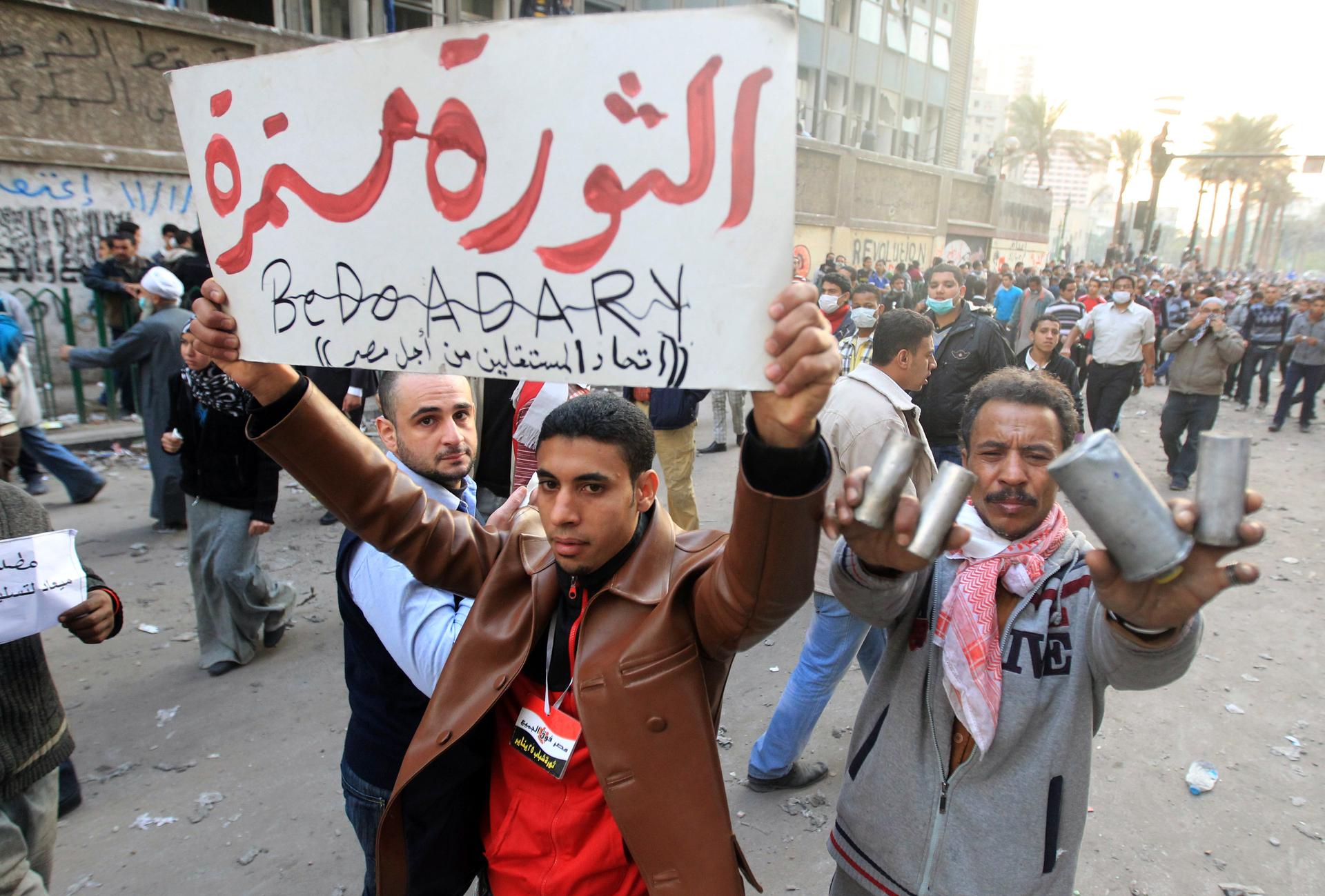Back to Tahrir Square
An Egyptian man holds up a banners that reads in Arabic, “The revolution is still running” during clashes on the third day with security forces at Tahrir Square in Cairo on November 21, 2011.
CAIRO — Nine months after millions of Egyptians chanted for freedom and toppled a regime that had long overstayed its welcome, thousands return to Tahrir Square, where it all started, calling for the downfall of Field Marshal Hussein Tantawi and his military rule.
In power since Mubarak’s ouster in February, the military is now being told that it too has overstayed its welcome.
On Sunday, standing on the outskirts of Tahrir Square, you hear a load roar; panic is both tangible and audible. “Run, run, run,” some men shout, as your legs obey his orders. Like a more chaotic version of a ten thousand person marathon, people sprint past you, shouting curse words. “Why are we running?” some are heard asking. “The army is here! The army has entered the square!” you hear amid gasps of air.
The battle between the Supreme Council of Armed Forces (SCAF) and the people began approximately one month after SCAF assumed power. A series of flagrant human rights violations, including subjecting thousands of civilians to military trials and applying demeaning virginity tests on Egyptian protesters has not gained them any points. The recent deadly clashes in Maspero attest to the scene in Egypt being far from stable. A military crackdown on a protest against the burning of a Christian community center soon turned into a chaotic bloodbath on October 9, reportedly killing 27 people.
If running Egypt were a popularity contest, Tantawy would be as unpopular as Mubarak was nine months ago, some would argue. A proposed document that would grant SCAF supra-constitutional policies and limit the authority of the parliament-to-be was the last straw for thousands of Egyptians who took to the Square last Friday.
Then on Saturday, just days before the first parliamentary elections in revolutionary-era Egypt, violence erupted. A sit-in of less than a thousand people was treated with brutal force by the notorious Egyptian police, actually one of the instigators of the people’s upheaval on January 25, which coincidentally (or not) is Police Day.
Omar Kandil, 22, felt “awesome” at 2 a.m. on Tuesday after spending a few hours in the packed Tahrir Square.
The area is reminiscent of the days of the revolution, Kandil says between coughs. He was sprayed with tear gas, as have thousands of others who poured into the square since Saturday. “People are chanting against field Marshall Tantawy, and there isn’t any violence in the square,” Kandil describes. But every few minutes, the crowds part to make way for injured protesters carried by ambulances, motorcycles, or fellow protesters.
The violence is concentrated in Mohamed Mahmoud street, which Kandil describes as a battlefield, where “people are fainting every 30 seconds, and it’s hard to see because of the tear gas.”
People on the front lines are in constant clashes with police and army officers, who have persistently fired tear gas and rubber bullets at protesters. Several have lost their eyes to projectiles. Doctors at a number of field hospitals spread across Tahrir report live ammunition fired through the bodies of protesters. Protesters break rocks and throw them at security forces in an attempt to hold ground. The security forces in turn fight to stop protesters from reaching the Ministry of Interior through Mohamed Mahmoud street.
While state TV continues to downplay events, social media is overflowing with eyewitness reports of Tahrir’s play-by-play. A group of young protesters decided to direct their efforts towards supplying field hospitals with much needed medical equipment. Through the hashtag #RescueTeam, they have gotten in touch with thousands of Twitter users who are willing to send supplies to Tahrir.
Roaming around the square in bright yellow vests and shiny helmets on Monday were Adham Aboul Einein, 25, and a group of friends. “We brought batches of supplies into Tahrir, and distributed them to hospitals where they were most needed,” Aboul Einein says.
Kandil was last in the square on February 11, when “objectives were clear.” But now, he says despite the fact that people are in good spirits, there in no real direction or end in sight.
The square is filling up once more, with many injured, a stream of tweets coming out and piles of supplies going into Tahrir. With a growing death toll (28, according to Egypt’s Ministry of Heath) and elections — on paper — less than a week away, the fate of Egypt’s transition of power has never been more questionable or more demanded.
Every day, reporters and producers at The World are hard at work bringing you human-centered news from across the globe. But we can’t do it without you. We need your support to ensure we can continue this work for another year.
Make a gift today, and you’ll help us unlock a matching gift of $67,000!
